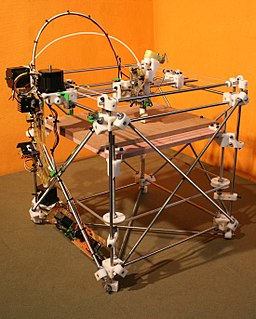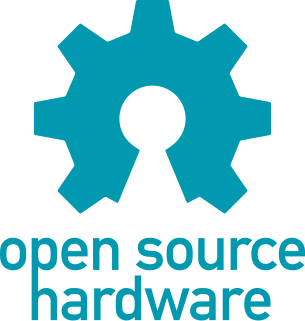
The open-design movement involves the development of physical products, machines and systems through use of publicly shared design information. This includes the making of both free and open-source software (FOSS) as well as open-source hardware. The process is generally facilitated by the Internet and often performed without monetary compensation. The goals and philosophy of the movement are identical to that of the open-source movement, but are implemented for the development of physical products rather than software. Open design is a form of co-creation, where the final product is designed by the users, rather than an external stakeholder such as a private company.

Open-source hardware (OSH) consists of physical artifacts of technology designed and offered by the open-design movement. Both free and open-source software (FOSS) and open-source hardware are created by this open-source culture movement and apply a like concept to a variety of components. It is sometimes, thus, referred to as FOSH. The term usually means that information about the hardware is easily discerned so that others can make it – coupling it closely to the maker movement. Hardware design, in addition to the software that drives the hardware, are all released under free/libre terms. The original sharer gains feedback and potentially improvements on the design from the FOSH community. There is now significant evidence that such sharing can drive a high return on investment for the scientific community.

Open educational resources (OER) are freely accessible, openly licensed text, media, and other digital assets that are useful for teaching, learning, and assessing as well as for research purposes.
Commons-based peer production (CBPP) is a term coined by Harvard Law School professor Yochai Benkler. It describes a model of socio-economic production in which large numbers of people work cooperatively; usually over the Internet. Commons-based projects generally have less rigid hierarchical structures than those under more traditional business models. Often—but not always—commons-based projects are designed without a need for financial compensation for contributors. For example, sharing of STL design files for objects freely on the internet enables anyone with a 3-D printer to digitally replicate the object saving the prosumer significant money.
Ralf Hotchkiss is an inventor and designer whose company, Whirlwind Wheelchair International, designs wheelchairs for use and manufacture in developing countries, involving wheelchair riders in all of its projects and activities. The organization's mission is "To make it possible for every person in the developing world who needs a wheelchair to obtain one that will lead to maximum personal independence and integration into society."

Openmoko was a project to create a family of open source mobile phones, including the hardware specification, the operating system, and actual smartphone development implementation like the Neo 1973 and Neo FreeRunner. The whole project was sponsored by Openmoko Inc.

The OLPC XO, previously known as the $100 Laptop, Children's Machine, and 2B1, is an inexpensive laptop computer intended to be distributed to children in developing countries around the world, to provide them with access to knowledge, and opportunities to "explore, experiment and express themselves". The XO was developed by Nicholas Negroponte, a co-founder of MIT's Media Lab, and designed by Yves Behar's Fuseproject company. The laptop is manufactured by Quanta Computer and developed by One Laptop per Child (OLPC), a non-profit 501(c)(3) organization.
The open-source model is a decentralized software development model that encourages open collaboration. A main principle of open-source software development is peer production, with products such as source code, blueprints, and documentation freely available to the public. The open-source movement in software began as a response to the limitations of proprietary code. The model is used for projects such as in open-source appropriate technology, and open-source drug discovery.

Open-source robotics (OSR) is where the physical artifacts of the subject are offered by the open design movement. This branch of robotics makes use of open-source hardware and free and open-source software providing blueprints, schematics, and source code. The term usually means that information about the hardware is easily discerned so that others can make it from standard commodity components and tools—coupling it closely to the maker movement and open science.

Chromium OS is a free and open-source operating system designed for running web applications and browsing the World Wide Web. It is the development version of Chrome OS, a Linux distribution made by Google.
Open-source appropriate technology (OSAT) is appropriate technology developed through the principles of the open-design movement. Appropriate technology is technology designed with special consideration to the environmental, ethical, cultural, social, political, and economic aspects of the community it is intended for. Open design is one that is public and licensed in such a way as to allow it to be used, modified and distributed freely.
The RoughRider wheelchair is a low-cost, durable and appropriate technology wheelchair designed for use in developing countries. The design of the RoughRider originally was open-source and has been revised with input from wheelchair users in over 40 countries since 1980. The RoughRider was created to fill the demand for a reliable wheelchair for over 20 million disabled people in the developing world who need a wheelchair and do not have one.
Open-source architecture (OSArc) is an emerging paradigm that advocates new procedures in imagination and formation of virtual and real spaces within a universal infrastructure. Drawing from references as diverse as open-source culture, modular design, avant-garde architectural theory, science fiction, language theory, and neuro-surgery, it adopts an inclusive approach as per spatial design towards a collaborative use of design and design tools by professionals and ordinary citizen users. The umbrella term citizen-centered design harnesses the notion of open-source architecture, which in itself involves the non-building architecture of computer networks, and goes beyond it to the movement that encompass the building design professions, as a whole.

Open Source Ecology (OSE) is a network of farmers, engineers, architects and supporters, whose main goal is the eventual manufacturing of the Global Village Construction Set (GVCS). As described by Open Source Ecology "the GVCS is an open technological platform that allows for the easy fabrication of the 50 types of industrial machines that it takes to build a small civilization with modern comforts". Groups in Oberlin, Ohio, Pennsylvania, New York and California are developing blueprints, and building prototypes in order to pass them on to Missouri. The devices are built and tested on the Factor e Farm in rural Missouri. Recently, 3D-Print reports OSE has been experimenting with RepRap 3-D printers as suggested by academics for sustainable development.
Microsoft .NET Gadgeteer is an open-source rapid-prototyping standard for building small electronic devices using the Microsoft .NET Micro Framework and Microsoft Visual Studio/Visual C# Express.

The Open Hardware and Design Alliance (OHANDA) aims at encouraging the sharing of open hardware and designs. The core of the project is a free online service where manufacturers of Open hardware and designs can register their products with a common label. This label maps the four freedoms of Free Software to physical devices and their documentation. It is similar to a non-registered trademark for hardware and can be compared to other certificates such as U.S. Federal Communications Commission (FCC) or CE mark. OHANDA thus has the role of a self-organized registration authority.
The Leveraged Freedom Chair (LFC) was an all-terrain wheelchair made from bicycle parts.
Open manufacturing, also known as open production, maker manufacturing, and with the slogan "Design Global, Manufacture Local" is a new model of socioeconomic production in which physical objects are produced in an open, collaborative and distributed manner and based on open design and open source principles.
Open source products include permission to use the source code, design documents, or content of the product. It most commonly refers to the open-source model, in which open-source software or other products are released under an open-source license as part of the open-source-software movement. Use of the term originated with software, but has expanded beyond the software sector to cover other open content and forms of open collaboration.








